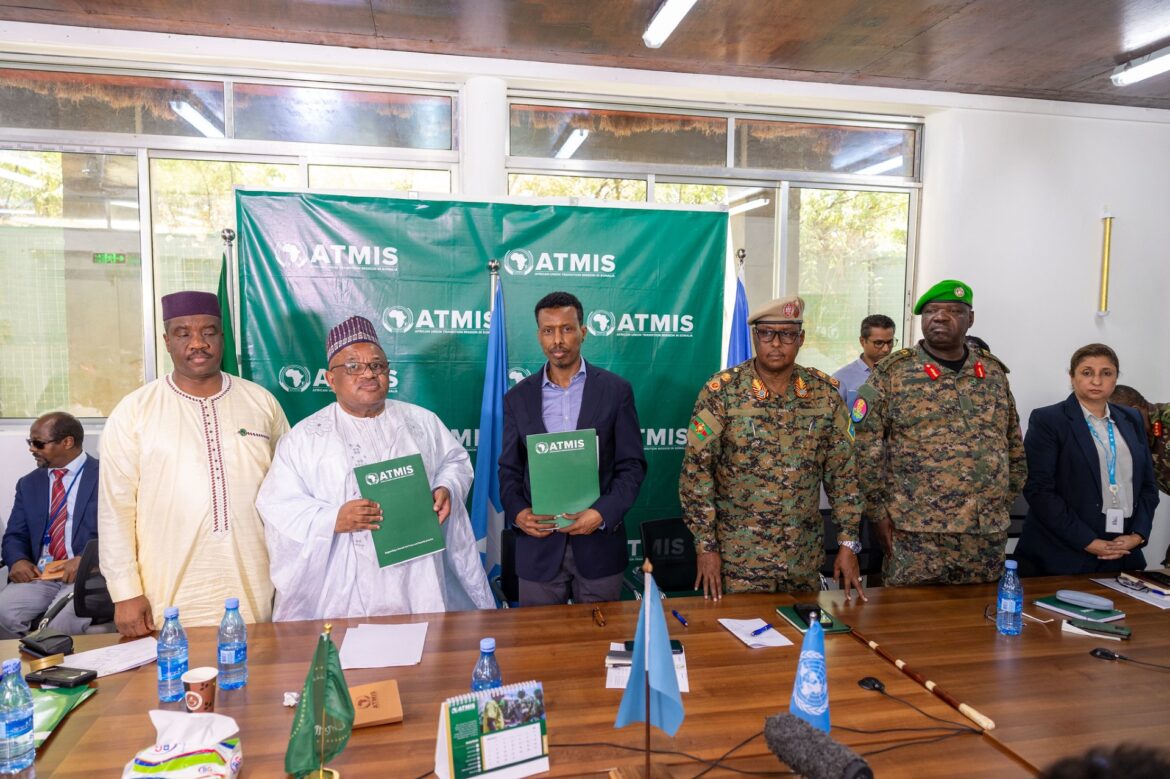
ADF STAFF
The African Union Mission in Somalia in late January completed the second phase of its military drawdown when it handed over nine military bases to the Somali government. The handover coincided with the withdrawal of 3,000 troops.
In the drawdown’s first two phases, 5,000 troops left Somalia and 13 military bases were turned over to Somali forces. The mission, known as ATMIS, includes troops from Burundi, Djibouti, Ethiopia, Kenya and Uganda.
Alhaji Sarjoh Bah, director of conflict management within the Political Affairs, Peace and Security Department of the AU Commission, said the second drawdown indicates that Somalia might be prepared to handle all security responsibilities in the country by the end of 2024, when the mission is expected to have completely withdrawn.
“The successful completion of this drawdown phase, notwithstanding significant challenges, including the El Niño [weather pattern], is a testament to the will of the Federal Government of Somalia to an orderly transition,” Bah said during a handover ceremony in Mogadishu.
Officials initially expected to complete the second phase of the ATMIS withdrawal at the end of September. However, ongoing al-Shabaab offensives, coupled with the retreat of forces from areas previously captured, persuaded the Somali government to ask for a delay in the drawdown.
Phase 3 Planning
Planning for Phase 3 of the drawdown began in February during a four-day conference attended by the mission’s commanders. This phase is expected to include the departure of 4,000 more troops in June.
AU Special Representative for Somalia and Head of ATMIS, Ambassador Mohamed El-Amine Souef, said he believes security forces are entering the “most critical stage of the mission.”
“It’s not easy, but we must surmount the challenges by remaining on the maximum alert during the transition period,” Souef said in an ATMIS news release.
ATMIS Force Commander Lt. Gen. Sam Okiding of Uganda said the commanders deliberated on a wide range of issues. “We examined Somalia’s security situation and put into consideration the current al-Shabaab posture, as well as our mandate and the post-ATMIS security situation,” he said.
Although security forces have regained significant territory from al-Shabaab, the insurgent group is notoriously resilient. Al-Shabaab claimed responsibility for an attack on a military camp in Mogadishu that killed four Emirati troops and one Bahraini military officer days after the ATMIS conference ended.
The terrorists in mid-February claimed they fired mortars on ATMIS and Somali National Army camps in the central Galgaduud region that destroyed several buildings, according to Somalia’s Garowe Online news website.
Another suspected al-Shabaab attack killed three people in the central Mudug region, which Somali forces regained from al-Shabaab in September 2023. Galgaduud and Mudug are in central Somalia’s Galmudug State.
U.S. to Build Military Bases
United States military airstrikes in late January killed three al-Shabaab fighters during operations near the southern coastal city of Kismayo. A similar U.S. operation killed two more insurgents in mid-February in a remote part of Jubaland State in southern Somalia.
Days after the Jubaland operation, the U.S. government announced plans to build at least four military bases inBaydhabo, state capital of the Bay Region; Dhusamareb, a district in Galgaduud; Jowhar, the administrative capital of Middle Shabelle region; and Kismayo.
Somali President Hassan Sheikh Mohamud characterized the deal as a “crucial step” in enhancing Somali forces and eliminating al-Shabaab.
“This agreement aids our plans to free the country from Al-Shabaab and ensure security,” Mohamud said during a signing ceremony.
The Somali military’s Danab Brigade will be tied to the new bases. The military established the brigade in 2017 after an agreement between Somalia and the U.S. to recruit, train, equip, and mentor 3,000 men and women from across the country to build a strong infantry capability within the Somali National Army.
The brigade initially was made up almost exclusively of people from the country’s poorest regions. But its public perception rose over time, and now it is recruiting highly educated candidates, including at least one physician.
The Danab is considered a 72-hour quick-strike force and constantly seeks about 350 new recruits at a time for training to rotate into the battle space.
The post ATMIS Completes Second Phase of Drawdown Amid al-Shabaab Attacks appeared first on Africa Defense Forum.










